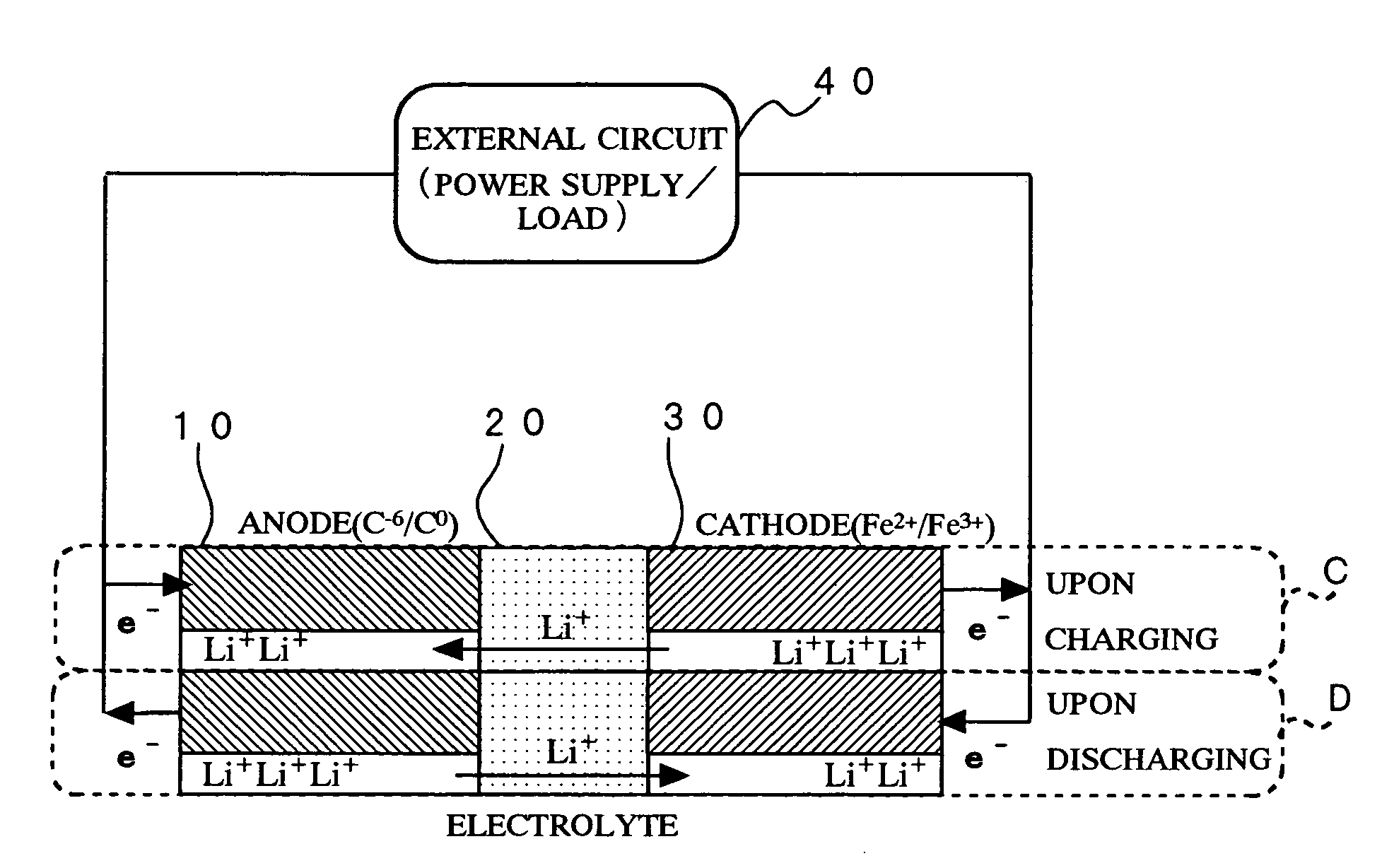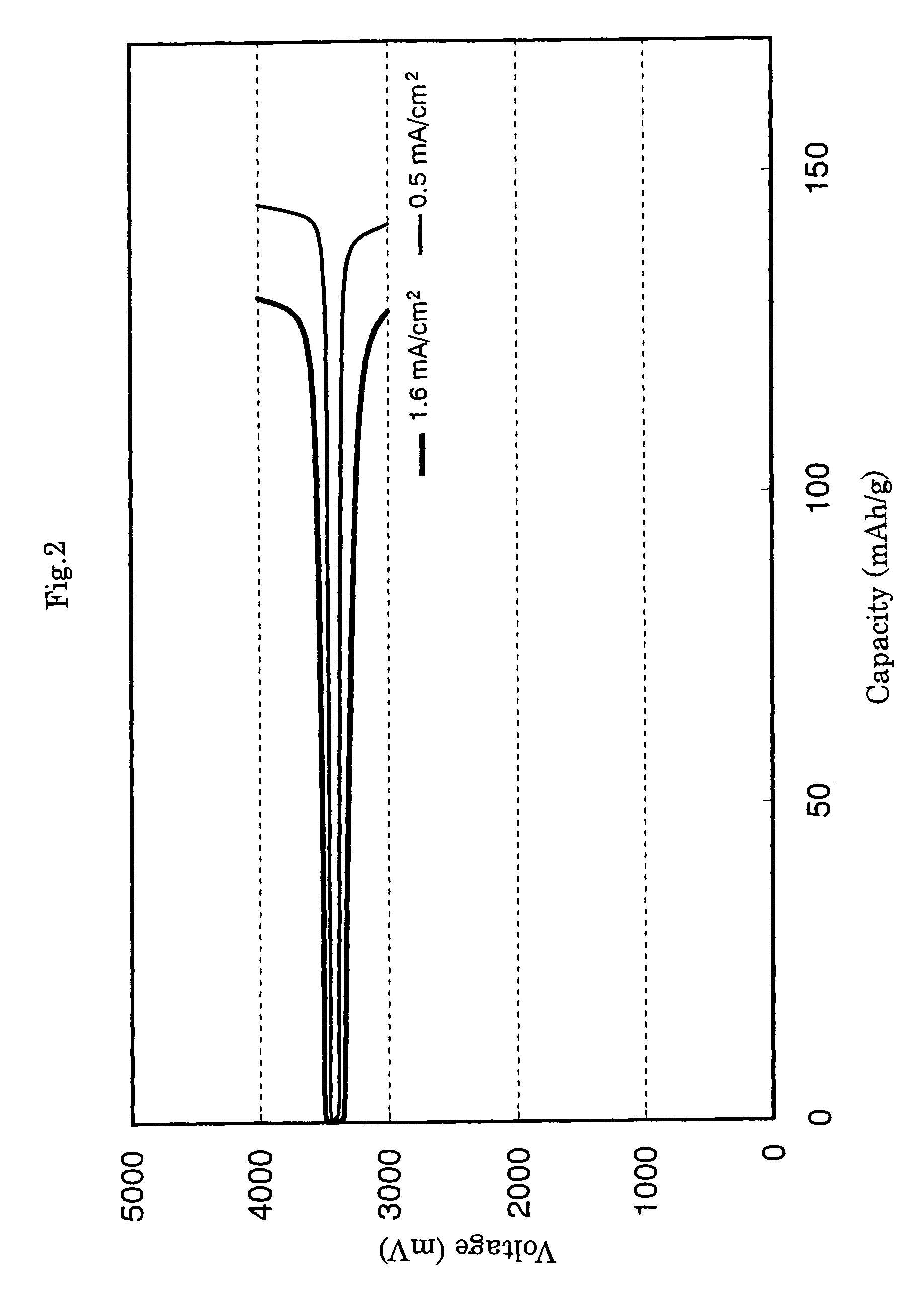Method of producing secondary battery cathode material, and secondary battery
a secondary battery and cathode material technology, applied in the direction of cell components, final product manufacturing, sustainable manufacturing/processing, etc., can solve the problems of difficult to charge or discharge at a relatively large current density, metal oxides, low conductivity, etc., to achieve easy movement, control of calcium content, and large surface area
- Summary
- Abstract
- Description
- Claims
- Application Information
AI Technical Summary
Benefits of technology
Problems solved by technology
Method used
Image
Examples
example 1
(1) Production of Cathode Material
[0084]A cathode material, LiFePO4, was synthesized by the following procedure.
[0085]FeC2O4.2H2O (5.0532 g; product of Wako Pure Chemical Industries, Ltd.), (NH4)2HPO4 (3.7094 g; product of Wako Pure Chemical Industries, Ltd.), LiOH.H2O (1.1784 g; product of Wako Pure Chemical Industries, Ltd.), and reagent-grade dextrin (0.5500 g; product of Wako Pure Chemical Industries, Ltd.) were separately pulverized in agate mortars and then mixed together. The mixture was placed in an alumina crucible and at first, was subjected to pre-calcination at 350° C. for 5 hours while feeding a mixed gas of 5% by volume of hydrogen (H2) and 95% by volume of argon (Ar) at a flow rate of 200 ml / minute. The thus-obtained pre-calcined mixture was taken out and pulverized in an agate mortar, and was further calcined at 675° C. for 24 hours in the same atmosphere (the feeding of the mixed gas was continued from before the start of heating, during the calcination and even aft...
example 2
[0095]As a cathode material containing conductive carbon derived from acetylene black, olivine-type LiFePO4 was obtained by a similar synthesis process as in Comparative Example 1 except that the feed gas employed upon calcination was changed to a mixed gas of 5 volume % hydrogen / 95 volume % argon gas and acetylene black [0.1000 g; prepared by pulverizing “Denka Black” (registered trademark, product of Denki Kagaku Kogyo K.K.; 50% pressed product) for 1 hour in an automated agate mortar] was added to and mixed with the raw materials in advance. The results of its analysis by powder X-ray diffraction and its primary grain size as determined by an observation with a scanning electron microscope are shown in Table 1. Further, a coin-type lithium secondary battery of a similar construction as in Example 1 was fabricated, and a charging / discharging cycle test was conducted in a similar manner as in Example 1. The average initial discharge capacities in the 1st to 20th cycles are also sho...
example 3
[0099]As a cathode material containing conductive carbon derived from acetylene black, olivine-type LiFePO4 was obtained by a similar synthesis process as in Comparative Example 1 except that the feed gas employed upon calcination was changed to a mixed gas of 8 volume % water (prevaporized water vapor) / 92 volume % argon gas and acetylene black [0.1000 g; prepared by pulverizing “Denka Black” (registered trademark, product of Denki Kagaku Kogyo K.K., 50% pressed product) for 1 hour in an automated agate mortar] was added to and mixed with the raw materials in advance. The results of its analysis by powder X-ray diffraction and its primary grain size as determined by an observation with a scanning electron microscope are shown in Table 1. Further, a coin-type lithium secondary battery of a similar construction as in Example 1 was fabricated, and a charging / discharging cycle test was conducted in a similar manner as in Example 1. The average initial discharge capacities in the 1st to ...
PUM
| Property | Measurement | Unit |
|---|---|---|
| temperature | aaaaa | aaaaa |
| temperature | aaaaa | aaaaa |
| temperature | aaaaa | aaaaa |
Abstract
Description
Claims
Application Information
 Login to View More
Login to View More - R&D
- Intellectual Property
- Life Sciences
- Materials
- Tech Scout
- Unparalleled Data Quality
- Higher Quality Content
- 60% Fewer Hallucinations
Browse by: Latest US Patents, China's latest patents, Technical Efficacy Thesaurus, Application Domain, Technology Topic, Popular Technical Reports.
© 2025 PatSnap. All rights reserved.Legal|Privacy policy|Modern Slavery Act Transparency Statement|Sitemap|About US| Contact US: help@patsnap.com



